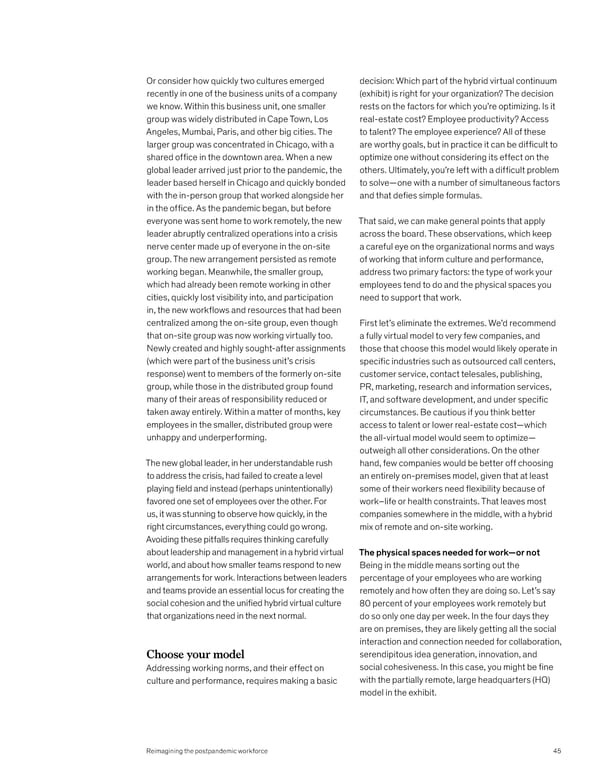Or consider how quickly two cultures emerged decision: Which part of the hybrid virtual continuum recently in one of the business units of a company (exhibit) is right for your organization? The decision we know. Within this business unit, one smaller rests on the factors for which you’re optimizing. Is it group was widely distributed in Cape Town, Los real-estate cost? Employee productivity? Access Angeles, Mumbai, Paris, and other big cities. The to talent? The employee experience? All of these larger group was concentrated in Chicago, with a are worthy goals, but in practice it can be difficult to shared office in the downtown area. When a new optimize one without considering its effect on the global leader arrived just prior to the pandemic, the others. Ultimately, you’re left with a difficult problem leader based herself in Chicago and quickly bonded to solve—one with a number of simultaneous factors with the in-person group that worked alongside her and that defies simple formulas. in the office. As the pandemic began, but before everyone was sent home to work remotely, the new That said, we can make general points that apply leader abruptly centralized operations into a crisis across the board. These observations, which keep nerve center made up of everyone in the on-site a careful eye on the organizational norms and ways group. The new arrangement persisted as remote of working that inform culture and performance, working began. Meanwhile, the smaller group, address two primary factors: the type of work your which had already been remote working in other employees tend to do and the physical spaces you cities, quickly lost visibility into, and participation need to support that work. in, the new workflows and resources that had been centralized among the on-site group, even though First let’s eliminate the extremes. We’d recommend that on-site group was now working virtually too. a fully virtual model to very few companies, and Newly created and highly sought-after assignments those that choose this model would likely operate in (which were part of the business unit’s crisis specific industries such as outsourced call centers, response) went to members of the formerly on-site customer service, contact telesales, publishing, group, while those in the distributed group found PR, marketing, research and information services, many of their areas of responsibility reduced or IT, and software development, and under specific taken away entirely. Within a matter of months, key circumstances. Be cautious if you think better employees in the smaller, distributed group were access to talent or lower real-estate cost—which unhappy and underperforming. the all-virtual model would seem to optimize— outweigh all other considerations. On the other The new global leader, in her understandable rush hand, few companies would be better off choosing to address the crisis, had failed to create a level an entirely on-premises model, given that at least playing field and instead (perhaps unintentionally) some of their workers need flexibility because of favored one set of employees over the other. For work–life or health constraints. That leaves most us, it was stunning to observe how quickly, in the companies somewhere in the middle, with a hybrid right circumstances, everything could go wrong. mix of remote and on-site working. Avoiding these pitfalls requires thinking carefully about leadership and management in a hybrid virtual The physical spaces needed for work—or not world, and about how smaller teams respond to new Being in the middle means sorting out the arrangements for work. Interactions between leaders percentage of your employees who are working and teams provide an essential locus for creating the remotely and how often they are doing so. Let’s say social cohesion and the unified hybrid virtual culture 80 percent of your employees work remotely but that organizations need in the next normal. do so only one day per week. In the four days they are on premises, they are likely getting all the social interaction and connection needed for collaboration, Choose your model serendipitous idea generation, innovation, and Addressing working norms, and their effect on social cohesiveness. In this case, you might be fine culture and performance, requires making a basic with the partially remote, large headquarters (HQ) model in the exhibit. Reimagining the postpandemic workforce 45
 What Now? Page 46 Page 48
What Now? Page 46 Page 48